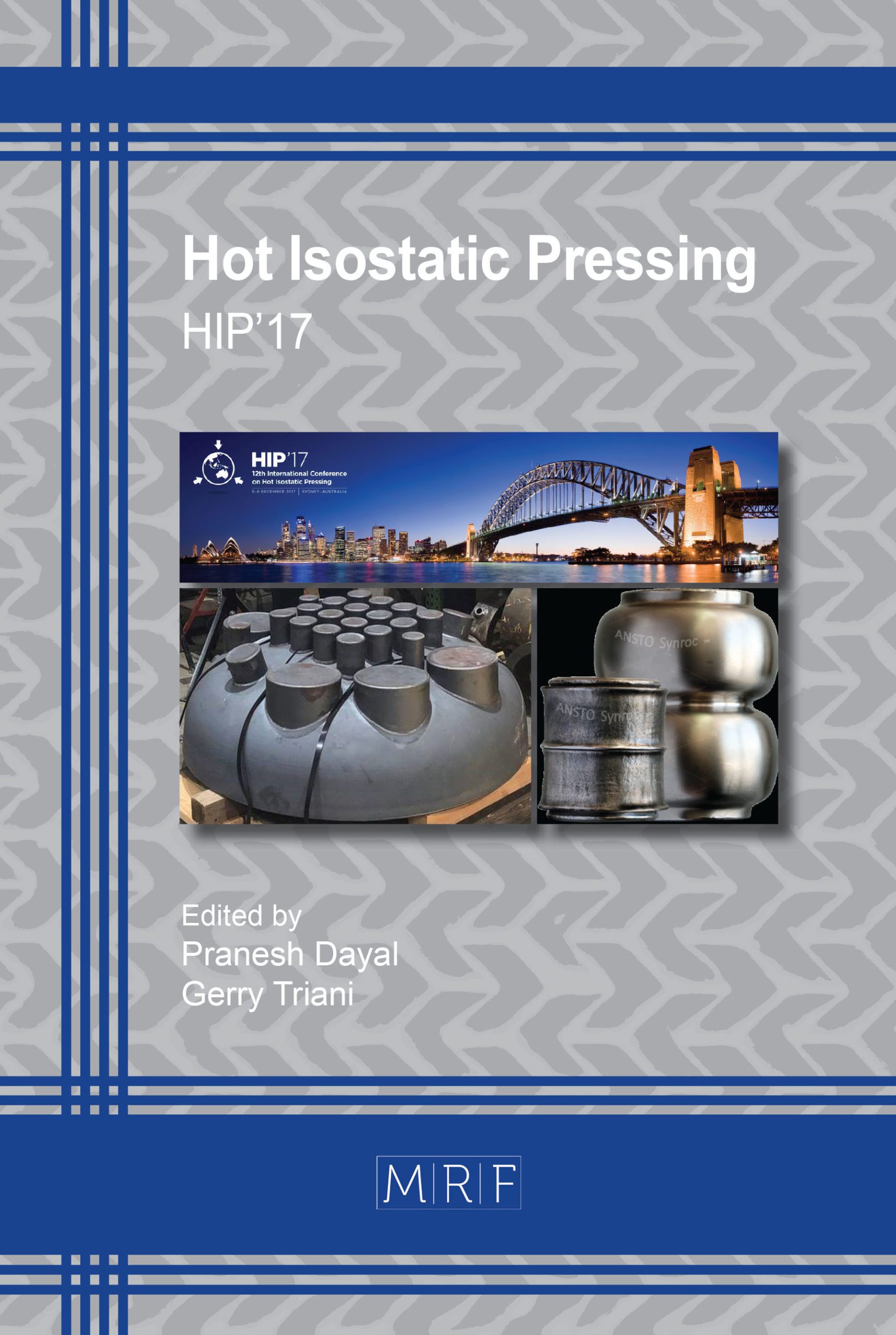Effects of Hafnium on Microstructure and Mechanical Properties in as-HIPed FGH4097 Powder Metallurgy Superalloy
ZHANG Yi-Wen, JIA Jian, HAN Shou-Bo, LIU Jian-Tao
download PDFAbstract. New type powder metallurgy (PM) superalloy FGH4097 developed in China is applied in advanced aircraft engine hot section components such as turbine disc and compressor disc. FGH4097 alloy billets (Φ80×135mm) in the study were processed via plasma rotating electrode processing (PREP) powder making, hot isostatic pressing (HIP) forming and heat treatment. Range of powder size is 50~150μm. HIP parameters are 1180~1220℃, 130MPa and 4hrs. The heat treatment process of FGH4097 alloy billet is solution treatment plus three stages aging treatment. By means of metallurgical microscope, scanning electron microscope and physiochemical phase analysis, the influence of Hafnium with different contents on the grain size, γ′ phase, MC carbide in as-HIPed FGH4097 alloy have been studied, also influences of Hafnium contents on mechanical properties including tensile properties, stress rupture properties and fatigue crack propagation rate have been investigated. The results showed that Hf had no effect on grain size, γ′ phase size and MC carbide size and morphology. Hf promoted γ′ phase and MC carbide precipitation, changed γ′ phase and MC carbide chemical constitutions and accelerated the splitting of γ′ phase to preferably stable cubic. Proper Hf content plays a beneficial role in improving the comprehensive mechanical properties of FGH4097 alloy, which helps improve mechanical properties, including impact ductility, tensile plasticity, stress rupture life, and fatigue crack propagation resistance, also helps decrease notch sensitivity. FGH4097 alloy with 0.30wt%Hf content presents the optimum comprehensive mechanical properties.
Keywords
PM Superalloy, FGH4097, Hafnium, PREP, Mechanical Properties
Published online 2/11/2019, 9 pages
Copyright © 2019 by the author(s)
Published under license by Materials Research Forum LLC., Millersville PA, USA
Citation: ZHANG Yi-Wen, JIA Jian, HAN Shou-Bo, LIU Jian-Tao, Effects of Hafnium on Microstructure and Mechanical Properties in as-HIPed FGH4097 Powder Metallurgy Superalloy, Materials Research Proceedings, Vol. 10, pp 30-38, 2019
DOI: http://dx.doi.org/10.21741/9781644900031-5
The article was published as article 5 of the book Hot Isostatic Pressing
![]() Content from this work may be used under the terms of the Creative Commons Attribution 3.0 licence. Any further distribution of this work must maintain attribution to the author(s) and the title of the work, journal citation and DOI.
Content from this work may be used under the terms of the Creative Commons Attribution 3.0 licence. Any further distribution of this work must maintain attribution to the author(s) and the title of the work, journal citation and DOI.
References
[1] Evans D J, Eng R D. Development of a high strength hot isostatically pressed(HIP) disk alloy, MERL76, Hausner H H, Antes H W, Smith G D. Modern Developments in Powder Metallurgy. Washington: MPIF and APMI. 1982, Vol. 14, 51-63.
[2] Belov A F, Anoshkin N F, Fatkullin O Kh, et al. Features of alloying of high-temperature alloys obtained by the metallurgical method of granules, Bannikh O A. Heat-resistant and Zharostoye Steels and Alloys on the Nickel Base. Moscow: Science, 1984, pp. 31-40.
[3] Radavich J, Carneiro T, Furrer D, et al. Effect of processing and composition on the structure and properties of P/M EP741NP type alloys, Chinese Journal of Aeronautics, 20 (2007) 97-106. https://doi.org/10.1016/S1000-9361(07)60013-2
[4] Radavich J, Furrer D, Carneiro T, et al. The microstructure and mechanical properties of EP741NP powder metallurgy disc material, Reed R C, Green K A, Caron P, et al(Eds.), Superalloys 2008, TMS, Pennsylvania, 2008, pp. 63-72.
[5] Miner R V. Effects of C and Hf concentration on phase relations and microstructure of a wrought powder-metallurgy superalloy, Metallurgical Transactions A, 8 (1977) 259-263. https://doi.org/10.1007/BF02661638
[6] Larson J M, Volin T E, Larson F G. In: Braun J D, Arrowsmith H W, McCall J L. Microstructural Science, American Elsevier Pub, New York, 1977, pp. 209-217.
[7] Wang Y, Chen L Q, Khachaturyan A G. Kinetics of strain-induced morphological transformation in cubic alloys with a miscibility gap, Acta Metallurgica et Materialia, 41 (1993) 279-296. https://doi.org/10.1016/0956-7151(93)90359-Z
[8] Qiu Y Y. Retarded coarsening phenomenon of γ′ particles in Ni-based alloy. Acta Materialia, 44 (1996) 4969-4980. https://doi.org/10.1016/S1359-6454(96)00128-0
[9] Yoo Y S, Yoon D Y and Henry M F. The effect of elastic misfit strain on the morphological evolution of γ′- precipitates in a model Ni-base superalloy, Metals and Materials, 1 (1995) 47-61.
[10] Qiu Y Y. The splitting behavior of γ′ particles in Ni-based alloys, Journal of Alloys and Compounds, 270 (1998) 145-153. https://doi.org/10.1016/S0925-8388(98)00462-9
[11] Hardy M C, Zirbel B, Shen G. Developing damage tolerance and creep resistance in a high strength nickel alloy for disc applications, Green K A, Pollock T M, Haradra H, et al (Eds.), Superalloys 2004, TMS, Pennsylvania, 2004, pp. 83-90.
[12] Starink M J, Reed P A S. Thermal activation of fatigue crack growth: Analysing the mechanisms of fatigue crack propagation in superalloys, Materials Science and Engineering A, 491 (2008) 279-289. https://doi.org/10.1016/j.msea.2008.02.016
[13] Wlodek S T, Kelly M, Alden D. The structure of N18.Antolovich S D, Stusrud R W, Mackay R A, et al(Eds.), Superalloys 1992, TMS, Pennsylvania, 1992, pp. 467-476.
[14] Guédou J-Y, Augustins-Lecallier I, Nazé L, et al. Development of a new fatigue and creep resistant PM nickel-base superalloy for disk applications. Reed R C, Green K A, Caron P, et al (Eds.), Superalloys 2008, TMS, Pennsylvania, 2008, pp. 21-30.
[15] Flageolet B, Villechaise P, Jouiad M, Mendez J. Ageing characterization of the powder metallurgy superalloy N18. Green K A, Pollock T M, Haradra H (Eds.), Superalloys 2004, TMS, Pennsylvania, 2004, pp. 371-379.































